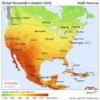glenhurst
Member
I suspect that the batteries in the trailer are actually for providing power *in* the trailer, e.g., lights, fans, etc. The article mentioned that when they stop for the night--presumably at campgrounds with 50 amp NEMA 14-50 outlets--the car will need the outlet. So, the solar charged batteries will be used in the trailer, not for the car.



